| ALL ABOUT BANNERS |
 |
|
Wherever we go, we are exposed to banners. Every day as we are driving to and from work, hopping on and off the bus or train, and walking through the downtown area, we see signage for hundreds of businesses, products, and events.
Because our modern urban world is so inundated with banners, any company choosing to advertise in this way must do what they can to make their banner stand out from the rest - to keep it from being just one more image our eyes gloss over as we pass.
This article discusses the wide sphere of banners: from printing and what's possible, to installation and applications.
|
SUMMARY
Banners are a useful method for advertising products and services in an eye-catching, highly visual style. Just like TV and radio ads, banners promote whatever a company or organization has to offer in the most arresting, memory-provoking way possible.
| MATERIALS |
QUALITIES |
DISPLAY |
APPLICATIONS |
- Fabric
- Vinyl
- Mesh
- Solvent or latex inks
- Dye Sublimation
|
- Sizes up to 12 feet
- Rectangular and some custom shapes
- Wide variety of material colors
- Ink color quality depends on printer type
- Lifespan depends on substrate and ink
|
- Hanging: ceiling, building, etc.
- Standing: banner stands and frames
- Adhesives: vehicle and wall, backlit displays
|
- Large scale: step and repeat, billboards, aerial advertising
- Mid-range: Store announcements, table and canopy banners
- Small scale: Personal, school, and charity events
|
|
| BANNER PRINTING
|
 |
MATERIALS
Depending on the intended application, budget, or required lifespan of a banner, different substrates may be used.
Cloth
Basic fabric is generally used only for indoor displays - it tends to absorb moisture, which can make it too heavy if left outdoors during precipitation. Fabric banners images have a soft, matte or satin finish without glare, and can last up to five years in direct sunlight, depending on the kind of ink used. They can often be washed like regular fabrics, and may be very lightweight or quite heavy, depending on the type of cloth.
Vinyl
Vinyl is the most common printed banner material. It is durable, weather-resistant, and flexible, which allows them to be displayed outdoors without fear of damage by rain or wind. There has been a lot of improvement in printable vinyl materials over the years, including more options for color and finish. Today, printable vinyl is available in a variety of colors including white, black, grey, and yellow, and in glossy or matte finishes.
Mesh
Mesh banners are another choice for outdoor displays. Because the material is woven, with tiny holes throughout, a very large banner can be hung quite tautly and still allow for air flow, without fear of being ripped by strong winds. They are a good alternative to the more traditional method of cutting slits in a solid vinyl or reinforced fabric banner because gusts of wind cannot fray the material.
INK
Solvent Inks, which contain chemicals that eat away at the material when placed, making an imprint of the image or text, as opposed to just a layer of ink on top. Commonly used for vinyl banners.
Dye Sublimation is a printing process that imbeds the ink in the fibers of polyester material, making it a scratch- and peel-proof option. Often used for fabric banners.
Latex Inks are an odorless alternative to solvent inks which require no drying time and are said to have improved durability on vinyl.
PRINTERS
Since banners are often quite large in size, wide-format printers are used for most banner printing. An ink jet printer that uses solvent or latex inks will generally be wide-format, since small prints using solvent ink are less common. In the case of dye sublimation, any brand of ink jet printer for which dye cartridges have been designed can print the transfer sheets that are used in the process.
Solvent printers, like the Epson SCS30670PE model shown to the right, are high capacity machines that generally offer very fast print speeds and wide print widths - in this case 64". The four, fast-drying inks (cyan, magenta, yellow, and black) have been chemically altered to be odorless, which solves a traditional problem with solvent ink printers: they once required excessive ventilation due to the strong, toxic fumes produced. This printer can be used to create vehicle wraps, and art reproductions, as well as regular outdoor banners and signage.
PRICE
Not only the most common banner option, vinyl is also generally the cheapest. Printers that offer banners in all the materials listed above charge less for vinyl than mesh or cloth. The latter two substrates are interchangeable, with some printers charging slightly more for one, and some slightly more for the other. The type of ink used by the printer will also affect the price.
|
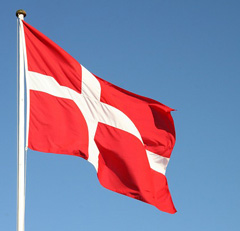
A fabric banner in the form of a flag
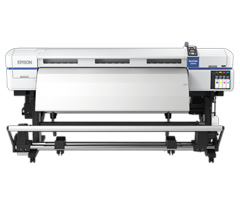
A solvent ink printer for banners
|
| BANNER LIMITS AND POSSIBILITIES
|
 |
SIZE
The maximum size available for banners depends on two things: the printer width, and the dimensions of the substrate.
As mentioned above, wide-format printers are almost always used in banner printing. But even the term "wide-format" has different meanings. The printer may have a maximum printable width of four feet to about 8 feet. Some industrial-sized printers are categorized as "Super Wide" or "Grand" format, and can print as wide as 16 feet.
Since banner substrates are flexible, they generally come in rolls. This means the maximum length is virtually unlimited. Most rolls are forty or more feet long.
SHAPES
While rectangular remains the most common banner shape, some other shapes are becoming popular. While some banner substrates can simply be cut into whatever shape the customer wants, many will tear or fray if they are not properly seamed around the edges, especially once grommets and ropes are applied.
Even within the realm of the rectangle, many different styles can be created. Very long, thin banners are primarily text, announcing a sale, concert, or festival, and often stretched over roads or isles in a small. Thin vertical banners may be hung from ceilings or signposts. Thicker rectangular or square shapes are commonly displayed across blank building walls or displayed like billboards between poles.
"Teardrop" shaped banners are one style that is often seen these days. Outfitted with a special banner pole, these signs are curved at the top and taper to a point at the bottom, like an upsidedown raindrop. These banners only work with stands, however, and are not seen hanging on buildings or over streets.
COLORS
Color applies to both the printed substrate and the inks.
Most materials are available in a variety of colors, limited only by what the printer keeps in stock. Vinyls are becoming available in more and more bold colors like blue, yellow, and red, as is mesh, while fabrics have always offered a lot of choice.
Ink color options depend on the quality of the printer. Traditionally, dye sublimation and ink jet inks were not available in white. As a result, any white in the digital image would appear instead the color of the substrate. While this is not a problem for white substrates, it does become an issue on colored surfaces. In recent years, however, white inks have been made available, though their use often requires the purchase of a special adaptor for the printer.
Beyond the white issue, wide-format printers can create thousands of colors. Though less expensive printers with fewer colors (four print heads instead of 8 or 12, for example) will be capable of a smaller range of shades and tonal variances, most printers today can match most colors with relative ease.
QUALITY
The quality of a printed banner is directly related to the quality of the material and the inks. Many vinyls are intended to last for years - anywhere from two to a dozen, depending on the environment and materials used. This lifespan includes the solvent inks that were used. Mesh banners are generally made from or coated in a similar plastic substance, and can easily last as long as vinyl.
Fabric banners are not expected to last as long as vinyl, although they will certainly last longer indoors than out. Outdoors, these banners are expected to last two to three years, assuming they are somewhat protected from the elements. Indoors, however, they should last considerably longer, though the sun will still cause them to fade over time.
|
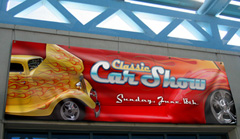
A vinyl banner for a car show
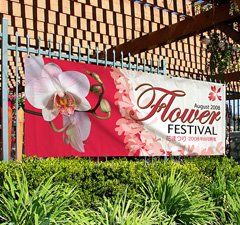
A vinyl banner announcing an event
|
| BANNER DISPLAY
|
 |
Once a banner has been printed, there are many ways in which is can be displayed.
HANGING
Perhaps the most common way of displaying a banner is to hang it. Most large banners come with grommets (metal rings) that pierce the material every few feet and allow for rope or cord to be strung through. The ends of the rope are fed through the grommets in each corner, then tied off on poles, building corners, or fence posts, stretching the banner between them. Depending on the weight and length of the banner, it may be necessary to secure the banner from other points along its length as well.
In addition to a horizontal display, banners can also be hung vertically. This is often seen in high-ceiling halls during trade shows, or in shopping malls. A vertically hung banner may need to be weighted at the bottom, depending how the weight the material.
One rope-free method of displaying banners is to have a fold-over seam sewn into them. This allows the banner to be slipped over a narrow rod along the top, or both bottom and top. This method is not ideal for windy climates, however, as a banner unsecured at the bottom will easily become wrapped around the top beam, and one secured on both ends may rip.
STANDING
Banner stands or frames are a popular alternative to ropes, and come in a wide range of styles intended for various applications. Some stands clip the banner between two bars and can be adjusted to suit the height of the sign, and even rotated to suit vertical and horizontal options. Many of these stands are also retractable, allowing the banner to be rolled up safely inside the base when not in use.
Other styles include circular stands that allow the banner to wrap around in an oblong shape, or frames that curve the other way to form a concave display. There are also sandwich board frames (a sturdier style that may be suitable for exteriors), the teardrop style mentioned above, and custom frames that are designed to hold one specific banner shape.
Banner stands are generally intended for indoor use. If used outside, they need to be weighted to avoid toppling over. Displays like these are most commonly seen at trade shows.
ADHESIVES
Today, more and more materials are offering an adhesive option. Both vinyl and fabric sign materials can be selected with a peel-off, pressure-sensitive adhesive on the back. This allows these banners to be affixed to windows, walls, vehicles, and even floors or ceilings. While not what one generally thinks of when considering banners, the popularity of this option should not be overlooked.
|
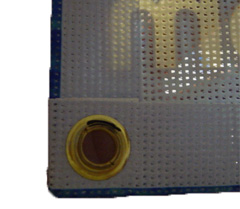
A grommet in the corner of a mesh banner
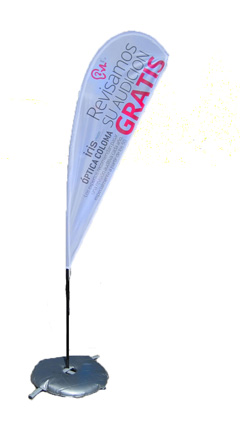
A teardrop banner
|
| BANNER APPLICATIONS
|
 |
|
There is no end to the applications for banners.
Step and Repeat Banners
The backdrops seen regularly at fashion shows, red carpet events, and sporting events are step and repeat. These banners are simply a method of making sure a brand name or image is viewed as continuously as possible. They feature a solid color background onto which the same image or text is placed repeatedly. Alternately, if more than one brand or team is being celebrated, the same method can be used to incorporate multiple images.
Billboards
A billboard - sometimes called a hoarding - is any large, outdoor advertising structure. Though banners are more commonly considered a free-standing or hanging alternative to billboards, they are generally the same nonetheless. Billboard signage is often printed on vinyl which is then affixed to the rigid surface of the large sign.
Pre-Printed Banners
Ideal for when budget or time is tight, pre-printed banners offer a general, non-personalized message. Large "Sale" signs with white letters and a red background are a popular example, as well as "Now Open," "Now Hiring," or "Closing" announcements. These banners have the advantage of drawing immediate attention because these images are universally recognizable.
Pole Banners
Most commonly seen on lamp posts in the downtown neighborhoods of towns and cities, pole banners are simply vertical vinyl or fabric banners that are affixed to rods that project horizontally from the vertical pole. They are used to advertise upcoming events, celebrate the season, or simply let passersby know in which area of the city they are.
Backlit Banners
Printed on a semi-translucent material, backlit banners can be placed in front of (or in the case of adhesives, attached directly to) a light source, creating an eye-catching lighted display. Thin vinyls and fabrics are often used for these banners, and they are commonly seen in subway halls, on bus stop shelters, and occasionally even billboards.
Table Covers
An alternative to hanging fabric banners, table covers are seen at many trade shows and recruitment sessions. They provide advertising on a different visual level than the usual overhead option. Some table covers can be draped over the entire table, with printing only on the overhanging sections. Others are simply a long thin banner than is placed to cover the table legs, often with clips or Velcro.
Canopy Banners
Another banner option similar to table coverings are the canopy banners seen at many street fairs, marathons, and other outdoor events. These banners work double duty, providing advertising for the business as well as shading products and employees from the sun.
Aerial Advertising
Whether in real life or the movies, everyone has seen a plane towing a large banner advertising a business or event, or asking someone to marry them. Using a special material that is lightweight but durable, these banners display text in extremely large lettering (as tall as five feet). The banners themselves can be 90 feet wide and are often assembled and flown by the same company who printed them.
Personal Banners
Though this article mainly discusses commercial uses for banners, many individuals choose to use them for their personal events as well. Banners strung across neighborhood fences can announce birthday parties, anniversaries, engagements, or garage sales. Schools may use banners to celebrate graduations and charities hang them to alert guests to fundraisers and other events.
|
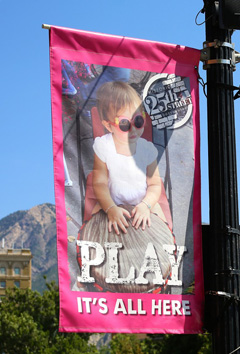
A fabric pole banner
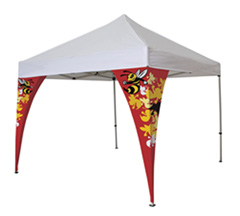
A canopy banner
|
|
While, like fine art reproduction, banners fall into the category of commercial printing, signage is primarily for outdoor use or indoor displays in direct sunlight, and is not intended to last more than a few years. This is partially due to the materials used, and also the fact that advertisements are often only required for short periods of time.
Alternately, fine art prints and canvas prints use higher quality inks and substrates, and retain their original appearance for decades or even centuries. As a result, banners are cheaper both to produce and to purchase.
|
|
© 2002-2024 - KeenART Media Ltd.
|
|
| |
|

